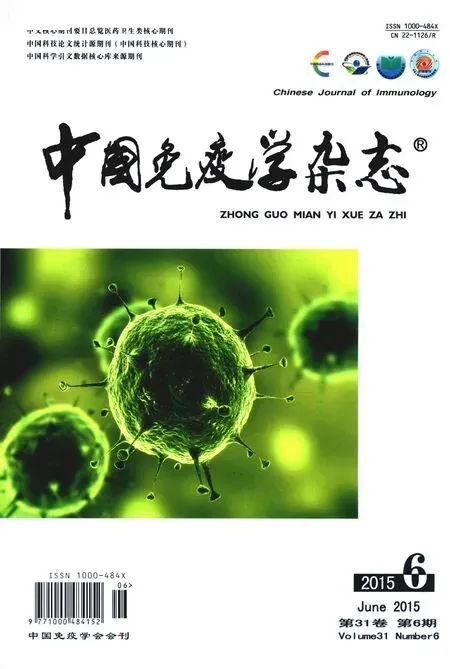恒定链辅助肿瘤免疫逃逸的研究进展①
2015-01-25刘雪兰许发芝安徽农业大学安徽省人兽共患病重点实验室合肥230036
刘雪兰 许发芝 (安徽农业大学安徽省人兽共患病重点实验室,合肥 230036)
恒定链(Invariant chain,Ii)属于Ⅱ型跨膜糖蛋白,在MHCⅡ类分子与抗原肽复合物的装配过程中发挥重要作用。在内质网中,Ii 在calnexin 辅助下形成三聚体,然后与MHCⅡ类分子的α 和β 链形成九聚体,占据Ⅱ类分子的抗原肽结合槽,阻止内源性抗原肽的结合,与MHCⅡ类分子聚合后将其靶向定位到内体中。此外,Ii 还能与MHCⅠ类分子结合,辅助MHCⅠ类分子进行抗原的交叉呈递[1]。早在1993 年,Saito 等[2]就发现Ii 不同程度地表达在人肾细胞癌(renal cell cancer,RCC)中而不表达在正常肾小管细胞中。除此之外,Ii 还高表达在胃癌、胰腺癌、淋巴白细胞病等肿瘤细胞表面[3-5]。Ii 在肿瘤细胞中的高表达现象表明,除了辅助MHC Ⅱ和MHCⅠ类分子呈递抗原外,Ii 与肿瘤细胞免疫逃逸有关。本文就Ii 在肿瘤细胞中高表达对肿瘤免疫的影响及其对禽类肿瘤免疫逃逸研究的提示进行综述。
1 肿瘤细胞中Ii 表达水平上调
在幽门螺旋杆菌诱发的胃癌组织中,Ii 表达的上调与胃癌细胞的增殖、肿瘤大小和肿瘤血管生成有关[6]。Jun 等[7]发现表达Ii 的非小细胞肺癌(non-small cell lung cancer,NSCLC)细胞具有较高的体外侵袭性和体内的转移性。具有较高神经侵袭能力的胰腺癌细胞系CaPan1 和CaPan2,Ii 的转录水平和蛋白表达水平都明显提高[4]。同样现象也出现在乳腺癌、慢性淋巴白血病等癌细胞中,预示Ii与肿瘤细胞免疫逃逸有关[8,9]。
2 Ii 高表达对肿瘤抗原的递呈有重要影响
保护性T 细胞免疫建立在抗原被有效呈递的基础上。在正常细胞中,作为MHCⅡ类分子的重要伴侣,Ii 在抗原递呈过程中发挥着重要作用。此外,研究结果表明,以Ii 为免疫载体,连接肿瘤、病毒等抗原肽的嵌合体疫苗能够增强机体的T 淋巴细胞参与的免疫,有效增强机体的抗肿瘤、抗病毒效应[10-13]。
然而,Ii 在多种肿瘤细胞表面的高表达很显然对肿瘤免疫并非发挥有效的辅助作用。肿瘤抗原是在细胞内产生的内源性抗原,Ii 在肿瘤细胞表面表达不仅没有起到辅助MHCⅠ和MHCⅡ类分子对肿瘤抗原进行递呈,相反,Ii 过表达通过抑制宿主免疫达到逃避细胞毒性T 细胞的攻击,而当去除Ii 时则可以提高肿瘤抗原的递呈[14-16]。
3 Ii 辅助肿瘤抗原逃逸机制的探索
目前,Ii 辅助肿瘤抗原逃逸的机制虽然尚未明确,但是相关研究可以部分揭示其潜在的机制。Rangel 等[17]报道了在卵巢癌等癌细胞中,细胞膜上Ii 大量表达时,HLA-DR(MHCⅡ类分子)没有发挥增强肿瘤免疫原性的正常效应,而是在细胞中表达HLA-DR α 链并减少HLA-DR β 链的表达(尽管可以检测到β 链的转录水平),由此导致了肿瘤细胞表达了比例较高的尚未成熟的HLA-DR,即使同时应用了MHCⅡ类分子反式激活因子CIITA 也难以激活抗肿瘤免疫[18]。这种抑制效应,Thompson等[19]在乳腺癌细胞系HLA-DR-MCF10 中得到了验证。当共转染MHCⅡ和CD80 而不转染Ii 时,肿瘤抗原疫苗能够激活CD4+Th1 淋巴细胞[20]。Ke等[15]通过siRNA 干扰Ii 表达,结果发现DCs 的抗癌能力明显提高,肿瘤增长受到抑制。Ii 在肿瘤细胞中过表达与MHCⅡ类分子关系并不近,相反Ii 表达水平变化时常伴随着MHCⅠ类分子表达的异常变化。一些肿瘤表面常常出现MHCⅠ不表达或表达水平很低[21,22],但是Jiang 等[23]通过免疫组化实验观察了人结肠癌和正常结肠的上皮细胞中Ii 与MHCⅡ类分子的表达,结果发现在前者中随着癌变程度从低到高,伴随着Ii 表达直线上升,而MHCⅡ类分子没有明显变化,使用该方法在正常细胞中没有检测到Ii 和MHCⅡ类分子的显著表达。在成熟的DC 中,当胞内MHCⅡ类分子表达量明显下降时,Ii 含量仍然很高[24]。相反,Liu 等[25]分析了多种癌细胞中Ii 分子的表达,发现了Ii 表达的上调并伴随着MHCⅠ类分子表达水平的升高,在癌症病人血清中含有较高水平的MHC Ⅰ类分子[26]。Ke等[15]通过siRNA 干扰Ii 表达后发现DCs 抗癌能力的明显提高,通过流式细胞技术分析后得到除CD4+T 淋巴细胞(主要识别MHC Ⅱ-抗原肽复合物)升高以外,CD8+T 淋巴细胞(主要识别MHCⅠ-抗原肽复合物)被激活的比例也明显升高。此外,研究结果证实,Ii 能够辅助MHCⅠ类分子在细胞表面的表达,即使在Ii△20(缺少内体定位序列的Ii 突变体)中,也不影响I 类分子的迁移[27]。Van 等[28]也发现如果Ii 被沉默则导致细胞表面MHCⅠ类分子表达的降低。
由此表明,Ii 辅助肿瘤免疫逃逸可能并非仅通过调控MHCⅡ类分子,很可能通过某种机制与细胞中MHC Ⅰ类分子相互作用,参与了肿瘤的免疫耐受。
4 肿瘤细胞中Ii 的关联分子
近年来围绕Ii 的相关研究进一步揭示其经典的辅助抗原递呈功能,Ii 还能作为信号分子的研究结果受到了关注。Ii 作为结合巨噬细胞迁移抑制因子(MIF)和幽门螺旋杆菌(Helicobacter pylori,H.pylori)的受体[29,30],激活NF-κB 因子,诱导了促炎因子IL-8 的释放,而长期慢性炎症可能导致肿瘤的发生。此外,MIF 与Ii 结合后能够影响TLR 受体参与的免疫通路。已经证实,在被敲除MIF 基因的小鼠体内,直肠癌组织中检测不到TLR4 的表达,而在敲除该基因的小鼠体内可以检测到TLR4[31]。在卵巢癌中,TLR4 已经被证实能够促进肿瘤生长[32]。除TLR4 外,肿瘤微环境中TLR9 信号也促进了肿瘤放疗后的复发[33]。在小鼠Lewis 肺癌(LCC)中,可以检测到TLR 1~6 和TLR9 等组成性表达,在受到淋巴细胞刺激后,TLR4 会明显增高,可能参与了肿瘤逃逸[34]。部分TLR 受体参与的免疫通路与MHCⅠ类分子和MHCⅡ类分子均有关[35,36]。而肿瘤细胞中Ii 高表达是否与TLR 等受体有关尚不清楚,有待于进一步研究。
5 问题与展望
肿瘤细胞Ii 的异常表达促使人们加深对Ii 功能的认识。肿瘤细胞表面的Ii 与肿瘤细胞质中的Ii发挥着不同的生物效应。尽管人们已经发现,表达在肿瘤细胞表面的Ii 并非像在正常细胞的胞浆中那样辅助抗原递呈而是起到相反的作用,从而揭示了Ii 与肿瘤细胞免疫逃逸有关,但是其调控机制还尚未明晰,还有许多问题有待探讨。为什么除去Ii后可以提高肿瘤细胞的抗原递呈能力或患瘤动物的免疫应答,而Ii 作为载体与肿瘤抗原肽连接却可以提高免疫应答?肿瘤细胞膜表面Ii 究竟通过何种机制抑制了胞内MHC 分子对肿瘤抗原的递呈,从而辅助了肿瘤抗原的免疫逃逸,这些均需进一步研究。随着免疫信号分子和免疫调控网络的深入研究,相信能够揭示Ii 与肿瘤免疫逃逸的相关机制。
[1]Basha G,Omilusik K,Chavez-Steenbock A,et al.A CD74-dependent MHC class I endolysosomal cross-presentation pathway[J].Nat Immunol,2012,13(3):237-245.
[2]Saito T,Tomita Y,Kimura M,et al.Expression of HLA class II antigen-associated invariant chain on renal cell cancer[J].Nihon Hinyokika Gakkai zasshi,1993,84(6):1036-1040.
[3]Tamori Y,Tan XD,Nakagawa K,et al.Clinical significance of MHC class II-associated invariant chain expression in human gastric carcinoma[J].Oncol Rep,2005,14(4):873-877.
[4]Koide N,Yamada T,Shibata R,et al.Establishment of perineural invasion models and analysis of gene expression revealed an invariant chain(CD74)as a possible molecule involved in perineural invasion in pancreatic cancer[J].Clin Res,2006,12 (8):2419-2426.
[5]Van Luijn MM,Westers TM,Chamuleau MED,et al.Class II-associated invariant chain peptide expression represents a novel parameter for flow cytometric detection of acute promyelocytic leukemia[J].Am J Pathol,2011,179(5):2157-2161.
[6]Keates S,Keates AC,Nath S,et al.Transactivation of the epidermal growth factor receptor by cag+Helicobacter pylori induces upregulation of the early growth response gene Egr-1 in gastric epithelial cells[J].Gut,2005,54(10):1363-1369.
[7]Jun Hyun Jung,Johnson Hannah,Bronson Roderick T.The oncogenic lung cancer fusion kinase CD74-ROS activates a novel invasiveness pathway through E-Syt1 phosphorylation[J].Cancer Res,2012,72(15),3764-3774.
[8]Greenwood C,Metodieva G,Al-Janabi K.Stat1 and CD74 overexpression is co-dependent and linked to increased invasion and lymph node metastasis in triple-negative breast cancer[J].J Proteomics,2012,75(10):3031-3040.
[9]Shachar I,Haran M.The secret second life of an innocent chaperone:the story of CD74 and B cell/chronic lymphocytic leukemia cell survival[J].Leukemia & Lymphoma,2011,52 (8):1446-1454.
[10]Gupta P,Goldenberg DM,Rossi EA,et al.Dual-targeting immunotherapy of lymphoma:potent cytotoxicity of anti-CD20/CD74 bispecific antibodies in mantle cell and other lymphomas[J].Blood,2012,119(16):3767-3778.
[11]Alinari L,Christian B,Baiocchi RA.Novel targeted therapies for mantle cell lymphoma[J].Oncotarget,2012,3(2):203-211.
[12]Xu M,Lu X,Sposato M,et al.Ii-Key/HPV16 E7 hybrid peptide immunotherapy for HPV16+cancers[J].Vaccine,2009,27(34):4641-4647.
[13]Zinckgraf JW,Sposato M,Zielinski V,et al.Identification of HLA class II H5N1 hemagglutinin epitopes following subvirion influenza A (H5N1) vaccination[J].Vaccine,2009,27 (39):5393-5401.
[14]Chornoguz O,Gapeev A,O'Neill MC,et al.Major histocom-patibility complex class II+invariant chain negative breast cancer cells present unique peptides that activate tumor-specific T cells from breast cancer patients[J].Mol Cell Proteomics,2012,11(11):1457-1467.
[15]Ke S,Chen XH,Zhu ZG,et al.Silencing invariant chains of dendritic cells enhances anti-tumor immunity using small-interfering RNA[J].Chin Med J(Engl),2010,123(22):3193-3199.
[16]Van Luijn MM,van den Ancker W,Chamuleau MED,et al.Absence of class II-associated invariant chain peptide on leukemic blasts of patients promotes activation of autologous leukemia-reactive CD4 (+)T cells[J].Cancer Res,2011,71 (7):2507-2517.
[17]Rangel LB,Agarwal R,Sherman-Baust CA,et al.Anomalous expression of the HLA-DR alpha and beta chains in ovarian and other cancers[J].Cancer Biol Ther,2004,3(10):1021-1027.
[18]Rickard S,Ono SJ.Invariant chain(+)N2a neuroblastoma cells stably expressing the class II MHC transactivator CIITA fail to stimulate anti-tumor immunity[J].Exp Mol Pathol,2008,85(3):147-154.
[19]Thompson JA,Srivastava MK,Bosch JJ.The absence of invariant chain in MHC II cancer vaccines enhances the activation of tumor-reactive type 1 CD4(+)T lymphocytes[J].Cancer Immunol Immun,2008,57(3):389-398.
[20]Ilkovitch D,Ostrand-Rosenberg S.MHC class II and CD80 tumor cell-based vaccines are potent activators of type 1 CD4(+)T lymphocytes provided they do not coexpress invariant chain[J].Cancer Immunol Immun,2004,53(6):525-532.
[21]Hasmim M,Badoual C,Vielh P,et al.Expression of EPHRINA1,SCINDERIN and MHC class Imolecules in head and neck cancers and relationship with the prognostic value of intratumoral CD8(+)T cells[J].BMC Cancer,2013,13:592.
[22]Baba T,Shiota H,Kuroda K,et al.Clinical significance of human leukocyte antigen loss and melanoma-associated antigen 4 expression in smokers of non-small cell lung cancer patients[J].Int J Clin Oncol,2013,18(6):997-1004.
[23]Jiang Z,Xu M,Savas L,et al.Invariant chain expression in colon neoplasms[J].Virchows Arch,1999,435(1):32-36.
[24]Landsverk Ole JB,Ottesen Anett H,Berg-Larsen Axel,et al.Differential regulation of MHC II and invariant chain expression during maturation of monocyte-derived dendritic cells[J].J Leukoc Biol,2012,91(5):729-737.
[25]Liu XD,Wang XJ,Capek HL,et al.Effect of invariant chain on major histocompatibility complex class I molecule expression and stability on human breast tumor cell lines[J].Cancer Immunol Immun,2009,58(5):729-736.
[26]Zhao J,Guo Y,Yan Z,et al.Soluble MHC I and soluble MIC molecules:potential therapeutic targets for cancer[J].Int Rev Immunol,2011,30(1):35-43.
[27]Reber AJ,Turnquist HR,Thomas HJ,et al.Expression of invariant chain can cause an allele-dependent increase in the surface expression of MHC class I molecules[J].Immunogenetics,2002,54(2):74-81.
[28]Van Luijn MM,van de Loosdrecht AA,Lampen MH,et al.Promiscuous binding of invariant chain-derived CLIP peptide to distinct HLA-I molecules revealed in leukemic cells[J].PLoS One,2012,7(4):e34649.
[29]Langham R,Kretzler M,Nair V.The MIF receptor CD74 in diabetic podocyte injury[J].J Am Soc Nephrol,2009,20(2):353-362.
[30]Beswick EJ,Pinchuk IV,Minch K,et al.The Helicobacter pylori urease B subunit binds to CD74 on gastric epithelial cells and induces NF-kappaB activation and interleukin-8 production[J].Infect Immun,2006,74:1148-1155
[31]Ohkawara T,Takeda H,Miyashita K,et al.Regulation of Tolllike receptor 4 expression in mouse colon by macrophage migration inhibitory factor[J].Histochem Cell Biol,2006,125:575-582.
[32]Kelly MG,Alvero AB,Chen R,et al.TLR-4 signaling promotes tumor growth and paclitaxel chemoresistance in ovarian cancer[J].Cancer Res,2006,66(7):3859-3868.
[33]Gao C,Kozlowska A,Nechaev S.TLR9 signaling in the tumor microenvironment initiates cancer recurrence after radiotherapy[J].Cancer Research,2013,73(24):7211-7221.
[34]Li C,Li HX,Jiang K.TLR4 signaling pathway in mouse Lewis lung cancercells promotes the expression of TGF-beta 1 and IL-10 and tumor cells migration[J].Bio-med Mater Eng,2014,24(1):869-875.
[35]Xu S,Liu X,Bao Y,et al.constitutive MHC class I molecules negatively regulate TLR-triggered inflammatory responses via the Fps-SHP-2 pathway[J].Nat Immunol,2012,13(6):551-559.
[36]Liu X,Zhan Z,Li D,et al.Intracellular MHC class II molecules promote TLR-triggered innate immune responses by maintaining activation of the kinase Btk[J].Nat Immunol,2011,12(5):416-424.
